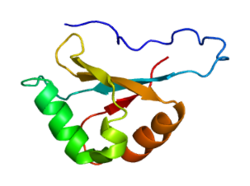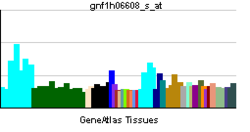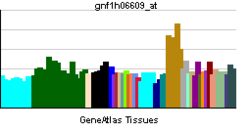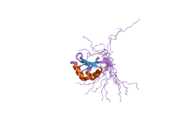- DDX50
-
DEAD (Asp-Glu-Ala-Asp) box polypeptide 50 
PDB rendering based on 2e29.Available structures PDB 2e29 Identifiers Symbols DDX50; GU2; GUB; MGC3199; RH-II/GuB External IDs OMIM: 610373 MGI: 2182303 HomoloGene: 56986 GeneCards: DDX50 Gene EC number 3.6.4.13 Gene Ontology Molecular function • nucleotide binding
• RNA binding
• helicase activity
• ATP binding
• ATP-dependent helicase activity
• hydrolase activityCellular component • nucleus
• nucleolusSources: Amigo / QuickGO RNA expression pattern 

More reference expression data Orthologs Species Human Mouse Entrez 79009 94213 Ensembl ENSG00000107625 ENSMUSG00000020076 UniProt Q9BQ39 Q5BKP5 RefSeq (mRNA) NM_024045 NM_053183.2 RefSeq (protein) NP_076950 NP_444413.1 Location (UCSC) Chr 10:
70.66 – 70.71 MbChr 10:
62.08 – 62.11 MbPubMed search [1] [2] ATP-dependent RNA helicase DDX50 is an enzyme that in humans is encoded by the DDX50 gene.[1][2]
DEAD box proteins, characterized by the conserved motif Asp-Glu-Ala-Asp (DEAD), are putative RNA helicases. They are implicated in a number of cellular processes involving alteration of RNA secondary structure such as translation initiation, nuclear and mitochondrial splicing, and ribosome and spliceosome assembly. Based on their distribution patterns, some members of this DEAD box protein family are believed to be involved in embryogenesis, spermatogenesis, and cellular growth and division. This gene encodes a DEAD box enzyme that may be involved in ribosomal RNA synthesis or processing. This gene and DDX21, also called RH-II/GuA, have similar genomic structures and are in tandem orientation on chromosome 10, suggesting that the two genes arose by gene duplication in evolution. This gene has pseudogenes on chromosomes 2, 3 and 4. Alternative splicing of this gene generates multiple transcript variants, but the full length nature of all the other variants but one has not been defined.[2]
References
- ^ Valdez BC, Yang H, Hong E, Sequitin AM (Mar 2002). "Genomic structure of newly identified paralogue of RNA helicase II/Gu: detection of pseudogenes and multiple alternatively spliced mRNAs". Gene 284 (1-2): 53–61. doi:10.1016/S0378-1119(01)00888-5. PMID 11891046.
- ^ a b "Entrez Gene: DDX50 DEAD (Asp-Glu-Ala-Asp) box polypeptide 50". http://www.ncbi.nlm.nih.gov/sites/entrez?Db=gene&Cmd=ShowDetailView&TermToSearch=79009.
Further reading
- Maruyama K, Sugano S (1994). "Oligo-capping: a simple method to replace the cap structure of eukaryotic mRNAs with oligoribonucleotides.". Gene 138 (1-2): 171–4. doi:10.1016/0378-1119(94)90802-8. PMID 8125298.
- Suzuki Y, Yoshitomo-Nakagawa K, Maruyama K, et al. (1997). "Construction and characterization of a full length-enriched and a 5'-end-enriched cDNA library.". Gene 200 (1-2): 149–56. doi:10.1016/S0378-1119(97)00411-3. PMID 9373149.
- Andersen JS, Lyon CE, Fox AH, et al. (2002). "Directed proteomic analysis of the human nucleolus.". Curr. Biol. 12 (1): 1–11. doi:10.1016/S0960-9822(01)00650-9. PMID 11790298.
- Scherl A, Couté Y, Déon C, et al. (2003). "Functional proteomic analysis of human nucleolus.". Mol. Biol. Cell 13 (11): 4100–9. doi:10.1091/mbc.E02-05-0271. PMC 133617. PMID 12429849. http://www.pubmedcentral.nih.gov/articlerender.fcgi?tool=pmcentrez&artid=133617.
- Strausberg RL, Feingold EA, Grouse LH, et al. (2003). "Generation and initial analysis of more than 15,000 full-length human and mouse cDNA sequences.". Proc. Natl. Acad. Sci. U.S.A. 99 (26): 16899–903. doi:10.1073/pnas.242603899. PMC 139241. PMID 12477932. http://www.pubmedcentral.nih.gov/articlerender.fcgi?tool=pmcentrez&artid=139241.
- Gerhard DS, Wagner L, Feingold EA, et al. (2004). "The status, quality, and expansion of the NIH full-length cDNA project: the Mammalian Gene Collection (MGC).". Genome Res. 14 (10B): 2121–7. doi:10.1101/gr.2596504. PMC 528928. PMID 15489334. http://www.pubmedcentral.nih.gov/articlerender.fcgi?tool=pmcentrez&artid=528928.
- Andersen JS, Lam YW, Leung AK, et al. (2005). "Nucleolar proteome dynamics.". Nature 433 (7021): 77–83. doi:10.1038/nature03207. PMID 15635413.
- Olsen JV, Blagoev B, Gnad F, et al. (2006). "Global, in vivo, and site-specific phosphorylation dynamics in signaling networks.". Cell 127 (3): 635–48. doi:10.1016/j.cell.2006.09.026. PMID 17081983.
PDB gallery Categories:- Human proteins
- Chromosome 10 gene stubs
Wikimedia Foundation. 2010.

